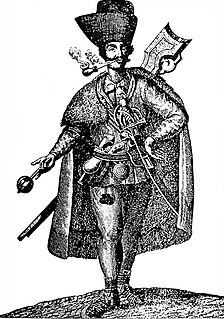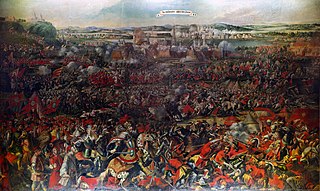 W
WThe Military Frontier was an important way in which Austria defended itself against the Ottomans. The following shown below is a history of the Austrian military history.
 W
WThe Arsenal is a former military complex of buildings in the south-east of Vienna in the third district.
 W
WThe Battle of Schwechat was a battle in the Hungarian Revolution of 1848, fought on 30 October 1848 between the revolutionary Hungarian Army against the army of the Austrian Empire, in Schwechat, near Vienna. This was the last battle of 1848 in the Transdanubian campaign. The Hungarian Army was under the command of János Móga and the Austrian Army was under the command of Alfred I, Prince of Windisch-Grätz.
 W
WThe Declaration of Neutrality was a declaration by the Austrian Parliament declaring the country permanently neutral. It was enacted on 26 October 1955 as a constitutional act of parliament, i.e., as part of the Constitution of Austria. Pursuant to resolution of the Federal Assembly of Parliament following the State Treaty, Austria declared "its permanent neutrality of its own accord." The second section of this law stated that "in all future times Austria will not join any military alliances and will not permit the establishment of any foreign military bases on her territory."
 W
WGrenz infantry or Grenzers were light infantry troops who came from the Military Frontier in the Habsburg Monarchy. This borderland formed a buffer zone between Christian Europe and the Ottoman Empire, and the troops were originally raised to defend their homelands against the Ottoman Turks. When there was no danger of war against the Ottomans, the Grenzer regiments were employed by the Habsburgs in other theatres of war, although one battalion of each regiment would always remain guarding the border.
 W
WThe Großer Zapfenstreich is a military ceremony performed in Germany and Austria. It is similar to the military tattoo ceremony performed in English-speaking countries, and is the most important ceremonial act executed by the German federal armed forces, the Bundeswehr, and by the Austrian federal armed forces Bundesheer. The Zapfenstreich is performed only during national celebrations and solemn public commemorations, to honour distinguished persons present at such special events. Examples are the farewell ceremony for a German federal president, or at the conclusion of large military exercises. It takes place in the evening hours and consists of a military formation of at least one military band, two platoons of armed infantrymen, and two lines of soldiers carrying torches, in total about 400 men.
 W
WThe Imperial and Royal or Imperial Austrian Army was strictly speaking, the armed force of the Holy Roman Empire under its last monarch, the Habsburg Emperor Francis II, although in reality, it was nearly all composed of the Habsburg army. When the Holy Roman Empire was dissolved in 1806, it assumed its title of the Army of the Austrian Empire under the same monarch, now known as Emperor Francis I of Austria.
 W
WThe Imperial Army, Imperial Troops, or Imperialists (Kaiserliche) for short, was a name used for several centuries, especially to describe soldiers recruited for the Holy Roman Emperor during the Early Modern Period. The Imperial Army of the Emperor should not be confused with the Army of the Holy Roman Empire (Reichsarmee), which could only be deployed with the consent of the Imperial Diet. The Imperialists effectively became a standing army of troops under the Habsburg emperor from the House of Austria, which is why they were also increasingly described in the 18th century as "Austrians", although its troops were recruited not just from the Archduchy of Austria but from all over the Holy Roman Empire of the German Nation.
 W
WThe July Putsch was a failed coup attempt against the Austrofascist regime by Austrian Nazis from 25 to 30 July 1934.
 W
WThe Battle of Leobersdorf was a battle fought near Leobersdorf on 19 September 1532, as part of the Habsburg-Ottoman War (1526–1568).
 W
WThe Imperial and Royal Minister of War, until 1911: Reich Minister of War (Reichskriegsminister), was the head of one of the three common ministries shared by the two states which made up the dual monarchy of Austria-Hungary from its creation in the Compromise of 1867 until its dissolution in 1918.
 W
WThe naval war on Lake Constance was a series of conflicts that took place on Lake Constance, beginning in 1632, in the context of the Thirty Years' War. At that time various powers ruled different parts of the shoreline: in the north and east was Roman Catholic, Habsburg Anterior Austria; in the northwest and west the troops of the Protestant Duchy of Württemberg with their allies from Kingdom of Sweden and Kingdom of France. These various powers sought, for strategic reasons, to exercise their hegemony over the area of Lake Constance. Only the partly Catholic and partly Protestant southern shore which belonged to the Old Swiss Confederacy maintained an uneasy neutrality due to their divided loyalties.
 W
WThe Quadrilatero is the traditional name of a defensive system of the Austrian Empire in the Lombardy-Venetia region of Italy, which connected the fortresses of Peschiera, Mantua, Legnago and Verona between the Mincio, the Po and Adige Rivers. The name refers to the fact that on a map the fortresses appear to form the vertices of a quadrilateral. In the period between the end of the Napoleonic Wars and the Revolutions of 1848, they were the only fully modernized and armed fortresses within the Empire.
 W
WThe Republikanischer Schutzbund was an Austrian paramilitary organization established in 1923 by the Social Democratic Party (SDAPÖ) to secure power in the face of rising political radicalization after World War I.
 W
WThe Serbian Free Corps, known simply as frajkori, was a volunteer militia composed of ethnic Serbs, established by the Habsburg Monarchy, to fight the Ottoman Empire during the Austro-Turkish War (1787–91). The conflict with Turkish forces ultimately proved inconclusive. The rebellion in the Sanjak of Smederevo and militia's operations resulted in the period of Habsburg-occupied Serbia, which took place from 1788 to 1792. Ultimately, the Serbian volunteer corps had the legacy of promoting the creation of future paramilitaries, such as during the First Serbian Uprising.
 W
WThe Siege of Vienna, in 1529, was the first attempt by the Ottoman Empire to capture the city of Vienna, Austria. The siege, led by Suleiman the Magnificent, came in the aftermath of the 1526 Battle of Mohács, which had resulted in the death of the King of Hungary, and the descent of the kingdom into civil war; several rival factions cooperated by in supporting the Habsburg Archduke Ferdinand I of Austria, while others supported the Ottoman-backed John Zápolya. The Ottoman attack on Vienna was part of their intervention into the Hungarian conflict, and in the short term intended to secure Zápolya's position. Historians offer conflicting interpretations of Ottoman long-term goals, and concerning the motivations behind their choice of Vienna as their campaign’s immediate target. The failure of that siege marked the beginning of 150 years of bitter military tension, punctuated by reciprocal attacks, and culminating in a second siege of Vienna.
 W
WThe Battle of Vienna took place at Kahlenberg Mountain near Vienna on 12 September 1683 after the imperial city had been besieged by the Ottoman Empire for two months. The battle was fought by the Holy Roman Empire led by the Habsburg Monarchy and the Polish–Lithuanian Commonwealth, both under the command of King John III Sobieski, against the Ottomans and their vassal and tributary states. The battle marked the first time the Commonwealth and the Holy Roman Empire had cooperated militarily against the Ottomans, and it is often seen as a turning point in history, after which "the Ottoman Turks ceased to be a menace to the Christian world". In the ensuing war that lasted until 1699, the Ottomans lost almost all of Hungary to the Holy Roman Emperor Leopold I.